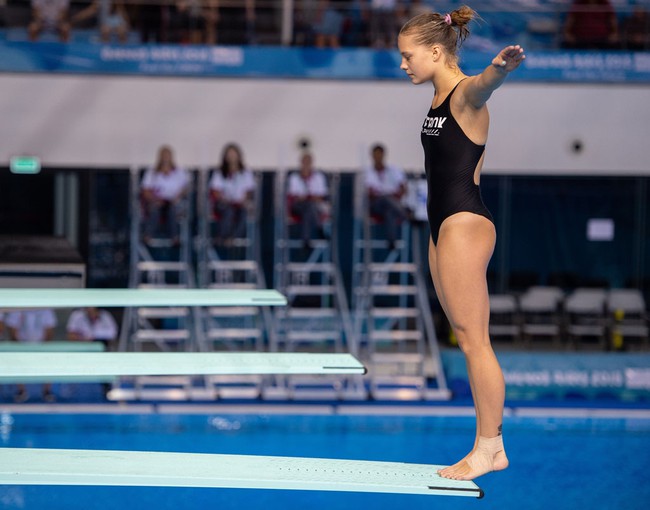Rules of the sport of diving
At the 31st SEA Games, athletes competing in diving will compete for 8/526 medal sets. The competition contents include 1m soft singles, 3m soft bridge singles, 3m soft doubles and 10m hard doubles. Each event will have 2 sets of medals, including 1 set of medals for the men’s event and 1 set of medals for the women’s event.
The diving event at the 31st SEA Games took place at My Dinh Water Sports Palace in Hanoi.
A few things to know about diving
Diving is the sport of jumping or falling into water from a platform or springboard while performing somersaults. It is internationally recognized as an Olympic sport and has been adopted in all Games around the world.
Diving is one of the most popular sports at the Olympics. Diving athletes possess many of the characteristics of acrobatic gymnasts. The strong countries in this subject can be mentioned as China, USA, Italy, Australia and Canada.

Athletes prepare to jump. Photo: Getty.
Artistic diving was adopted as an Olympic sport in 2000. Two athletes form a team and dive at the same time. The skills can be contrarian, also known as pinwheel, but this is no longer part of competitive synchronized diving.
Most diving competitions consist of three events: 1m, 3m and 10m hard bridge. Athletes compete by gender, and often by age group. In major competitions, including the Olympics and World Championships, professional diving is counted at 10m.
Diving athletes must perform a set number of jumps, including somersaults and twists. Athletes are evaluated on how well they complete all aspects of the dive, how well their bodies are adapted to the requirements of the dive, and how much water is ejected when they enter the water. One of the ten points can be divided into 3 points for pre-water, 3 points for the actual dive and 3 points for re-entry (how the diver hits the water) with one more point available for flexible judges.
The absolute score is multiplied by a difficulty factor level, derived from the number and combination of attempts attempted. The jumper with the highest total score after each jump is declared the winner.
Basic diving technique
Warm up before jumping
Up the boardwalk. If your board has a fulcrum, change it to your desired setting. One fulcrum is the side display wheel. It adjusts your spring depending on its position.
Go to the end of the game. If your board has cheese-shaped holes at the ends, then start about 2 inches (5.1cm) in front of them. If not, start at about a foot and a half from the end.
Take three steps. Make the first one a bit longer than your average step, then make the next two normal.
Stand high. You have found your starting point. This is where you should always start for a 3-step obstacle. Take a deep breath if you want, otherwise proceed to the next step.
Start walking like walking. Start with your dominant vacuum. You should do two normal steps, and then one slightly longer step.
Jump up: When your third step hits the board, swing your arms above your ears. Bring your knees to waist level at least 2-4 inches (5.1-10.2cm) from the bottom of the board. This means staying on the board throughout the downward bend and then jumping down when it reaches the neutral position to achieve maximum height. Perform a diving jump, acrobatics before plunging into the water.
Manipulation to perform the gainer on the shuttlecock

Gainer movement. Photo: Getty.
A gainer is a daring reverse jump that begins as a forward jump. To complete this jump successfully, you will have to perform a perfect hurdle jump to gain momentum. Once you’re off the board, keep your body tight to do the reverse flip before hitting the water. A gainer can be made with a tuck or pike formation depending on your preference and diving experience. To be safe and always do this jump in the presence of a coach or experience required. Here are the movements for soft diving, including 2 bouncing positions:
Take the momentum and jump forward taking 3 steps forward from the back of the board. Stay straight and move forward 3 steady steps, using the same step you would walk every day. Move fast enough to build momentum but not fast enough to slip and lose balance. Space your steps so your strong leg plants stretch. You may need to experiment to find the perfect starting point on the board. Normally, it takes about 5 steps from the end of the board.
Make your tap. Your fourth step should be longer and more exaggerated than the previous 3 steps. It will bring your foot forward to the end of the board. Place your press foot flat on the board and tuck your toes to 90 degrees.
Simultaneously, your feet lower on the press, bringing your arms behind your back. You will swing them overhead as you tiptoe. Rotate your arms above and above your head. As you press down on your final step, bring your arms upwards in a counterclockwise motion. Rotate them upwards so your shoulders are next to your ears. They should be fully extended above your head.
You should feel the board at the point where your arms swing over your hips toward your head.
Stand in place, bounce back and forth, and bend the other leg 90 degrees. Jump back up from your toes, straightening that leg. Bring your other leg to a 90-degree position in the air from its slightly bent position. Be sure to jump straight up without moving forward or backward.
Lower with both feet at the end of the board and bounce back. While you’re still in the air, bring your bent leg down. Lower at the end of the board with both feet. Use this landing to bounce back up.
Lower on the heels of your feet. As you jump into the air, point your toes. Avoid landing hard on your feet. Instead, lower as gently as possible on the heels of your feet.
Bend to create a bounce as you land on the edge of the board, bending your knees. Keep your head and body aligned and your arms straight. Keep your foot firmly on the board as it bends down after lowering your leg and jumping back up.
As the board lifts you, begin to straighten your knees. Use your calves to shape your body into a jump. Point your toes as soon as they start to lift off the board.
Raise your legs as you reach the height of the jump. Angle your jump off the board by lifting your legs as you reach the top of the jump. The momentum of the jump combined with the forward extension of your legs will propel you forward. This movement will also initiate the reverse turn that you will need to do for your jump. As you lift your legs, keep your hips straight. Allowing them to move up will ruin your jump form and it can send you back to the board.
The hard bridge has 3 jumping positions including running momentum, jumping forward; standing in place, jumping backwards; acrobatic banana plantation.
Advanced diving techniques
There are two main poses for performing flips.
The first position is “tucked” – bend your knees, hug your knees with your hands, curl up like a round ball, then perform a rotation and stretch to receive water. The second pose is “piked” – straighten the knees, hug the knees and shins with both hands, face down on the knees, then perform rotations, flips and stretches for water.
With “tucked”, the athlete will curl up like a ball and roll over. The rollover creates a moment of inertia pointing upwards, counteracting the acceleration of the fall. A slower fall means more time to perform pre-water spins.
With “piked”, this is a more difficult pose, because it does not create a large moment of inertia like the spinning form of “tucked”. It is also more difficult for a diving athlete to control the speed of rotation and flip in this position. Therefore, if done successfully, piked will be scored higher than tucked.
After performing the flip phase, the diving athlete will stretch to refuel.
As a general standard, a good watering phase is one in which the athlete dives into the water with minimal disturbance on the surface of the water. There is another pose where the athlete spreads his towel over the edge of the board. Prepare in a sitting position, extend your legs together and place your hands parallel to your shoulders; Slowly lift your butt and legs, then slowly pull your legs back up and bring them up in the banana tree position. Then bounce hard before performing a body roll or somersault.
To do that, athletes – whether in the water with their feet or in the banana position – must stretch to create a straight angle of falling into the water while falling at a speed of about 48km/h. This is not easy.
A perfect watering phase, also known as a “rip entry”, is a watering phase where the athlete falls vertically into the water, just tearing the surface of the water and causing tiny ripples. “Rip” in “rip entry” is the characteristic sound of that watering phase.
In terms of science, understanding the laws of physics such as rotation, friction, acceleration and the ability to perform body movements will create the most beautiful and impressive performance. . Diving athletes are people who bring the rules of physics to the level of art.
at Blogtuan.info – Source: danviet.vn – Read the original article here


